Introduction
Massively multiplayer online role-playing games (MMORPG’s) create virtual worlds with virtual economy. These virtual economies can be studied with the same methods the real economies are studied; Lehdonvirta (2005) has surveyed some early such attempts. A more general early review is that by Lastowka and Hunter (2004). A recent systematic introduction to virtual economies is done by Lehdonvirta and Castronova (2014). The present paper continues this line of research by focusing on inflation in the virtual economy created by one of the most popular MMORPG, namely World of Warcraft. To the best of our knowledge, no previous study has considered this question of in-game inflation at the level of the present paper.
World of Warcraft, which will be later referred to as WoW, is an MMORPG based on the earlier real-time strategy game series of Warcraft, with a worldwide player base in the millions. The game was released by Blizzard Entertainment in 2004 and has so far had six expansion packs, most recently Legion, released in 2016.
The study conducted displays the connections between a fictional virtual currency and real-world currencies as well as the possibility of real-world economic phenomena and monetary policies within a virtual game environment. It is observed that the value of WoW’s currency plummeted heavily against real-world currencies across the world after the release of the game’s newest expansion pack in August 2016. This observation confirms the hypothesis that the release of a new expansion pack leads to a vast increase in money supply, effectively reducing the currency’s value.
There are five server regions in WoW: North America, Europe, China, Taiwan and Korea. Each region has an array of realms on which they host their players. These servers will be examined in this study.
We suppose that the reader has some familiarity with the basic concepts of (real world) economy and their virtual counterparts as given by Lehdonvirta and Castronova (2014).
Methods
Massively multiplayer online role-playing games (MMORPG’s) create virtual worlds with virtual economy. These virtual economies can be studied with the same methods the real economies are studied; Lehdonvirta (2005) has surveyed some early such attempts. A more general early review is that by Lastowka and Hunter (2004). A recent systematic introduction to virtual economies is done by Lehdonvirta and Castronova (2014). The present paper continues this line of research by focusing on inflation in the virtual economy created by one of the most popular MMORPG, namely World of Warcraft. To the best of our knowledge, no previous study has considered this question of in-game inflation at the level of the present paper.
World of Warcraft, which will be later referred to as WoW, is an MMORPG based on the earlier real-time strategy game series of Warcraft, with a worldwide player base in the millions. The game was released by Blizzard Entertainment in 2004 and has so far had six expansion packs, most recently Legion, released in 2016.
The study conducted displays the connections between a fictional virtual currency and real-world currencies as well as the possibility of real-world economic phenomena and monetary policies within a virtual game environment. It is observed that the value of WoW’s currency plummeted heavily against real-world currencies across the world after the release of the game’s newest expansion pack in August 2016. This observation confirms the hypothesis that the release of a new expansion pack leads to a vast increase in money supply, effectively reducing the currency’s value. Both the prices of real currenciens (XE, 2017) and the prices of WoW tokens (Wowtoken, 2017) are freely available, and the prices and their changes are compared in the forthcoming chapters.
There are five server regions in WoW: North America, Europe, China, Taiwan and Korea. Each region has an array of realms on which they host their players. These servers will be examined in this study.
We suppose that the reader has some familiarity with the basic concepts of (real world) economy and their virtual counterparts as given by Lehdonvirta and Castronova (2014).
The Principles of Wow Virtual Economy
Players are able to purchase and sell various in-game items for in-game currency within WoW. This in-game currency is most commonly referred to as “gold” as it is the highest ranked currency, as opposed to silver and copper, and shall thus later be referred to as “WoW gold”. The currency comes in three forms: gold, silver and copper. A hundred pieces of copper is worth one piece of silver while a hundred pieces of silver is worth one piece of gold. Therefore, one piece of WoW gold is worth ten-thousand pieces of copper. To simplify this paper copper and silver shall be disregarded as WoW gold is the main form of currency referred to within the game.
The WoW Money Supply
Currency within the game is obtained through various methods. Players may earn it by completing various quests, selling obtained items to in-game vendors, completing dungeons and raids and gathering currency from dead foes. These methods for bringing new currency into circulation may be referred to as the WoW printing press.
The in-game currency may be taken out of circulation in one of two ways. The first method of taking in-game currency out of circulation is the use of the in-game currency on services and goods provided not by players but by the game itself. Where a player may pay a fee to a merchant in order to repair his/her gear, the money paid for the service is effectively taken out of circulation. Currency may also be removed from circulation simply by having the game’s players quit playing WoW.
WoW has had six expansions so far. With each expansion the game has experienced an increase in money supply due to expansionist monetary policies. This expansionist policy may be examined as simply as comparing the gold rewarded through questing in each expansion or the gold gain from defeating dungeons and raids.
It must be noted that the goods from older expansion packs might often become obsolete where newer goods replace them. A problem may arise here as the older product may have a larger supply than the newer substitute, which lowers the value of the older goods and raises the value of the newer, and scarcer, goods.
WoW Tokens
Players have the ability to effectively purchase in-game currency with real-world currency. It is a relatively recent function within WoW that players may purchase “WoW tokens” which other players have purchased on the marketplace for real world currency. Purchasing WoW tokens from other players has originally given the purchaser the ability to continue their game subscription for another month, whereas purchasing a monthly subscription would otherwise cost the player a monthly fee in real world currency.
These tokens are purchased at various prices depending on the location of the game server on which the player is located. They cost USD$20 on North American servers, 20€ or £15 on European servers, ¥75 on Chinese servers, NT$500 on Taiwanese servers and ₩22,000 on Korean servers (Wowtoken, 2017).
Players may purchase a maximum amount of ten tokens in a single week to sell and players may purchase a maximum amount of thirty-six tokens to use for game time during a two year period. Additionally, a player will not be able to have a token to sell and a bought token in his or her inventory at the same given time. The player may, however, have a maximum amount of ten tokens with either function in their inventory at a given time. For example, a player may own ten tokens to sell or ten tokens to use for game time at once, but the player may not own five tokens of each at the same time. The token purchased from the market to use is not resellable to other players. So, if a player purchases a game time token to use for game time he or she may not sell it again on the auction house. When purchasing a token to sell on the market to other players it must be sold on the server’s token auction at a chosen time and may not be used personally. These are the set limitations for WoW tokens and must thus be considered as a form of regulation. The impact of these regulations is debatable.
Figure 1 presents the price of purchasing a token on various servers adjusted to USD$ since January 2016, due to various currencies being used to purchase the tokens. The prices adjusted to USD$ differ greatly between servers, as can be seen in Figure 1. Purchasing a token, as of 25.04.2017, costs roughly USD$10.89 on Chinese servers, while on European servers they may cost between USD$19.21 and USD$21.77, depending on whether the player is purchasing the token with GBP(£) or the Euro(€), respectively (XE, 2017).
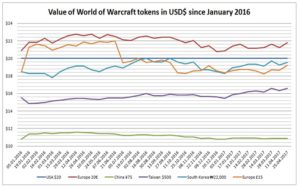
Figure 1: Value of World of Warcraft tokens in USD$ since January 2016
The amount of in-game currency required to purchase a WoW token may vary depending on the game server. These tokens may be sold on the in-game market for a fluctuating market price, as other players will then bid on the given token. This function for practically purchasing WoW gold with real-world currency connects WoW gold with the real-world currencies, providing an important perspective to the in-game economy of WoW by making these currencies practically convertible.
Examining statistics of the WoW token’s value in WoW gold on these various servers provides us with further insight. Figure 2 shows the value of tokens on the given servers since January 2016. Figure 3, however, shows the value of tokens on a more specific timescale from August 16 2016 which was a week after Blizzard started the pre-launch event for Legion, their newest expansion pack for WoW.
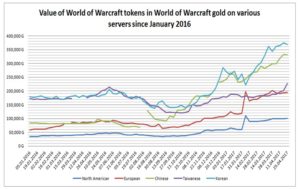
Figure 2: Value of WoW tokens in WoW gold on various servers since January 2016
As can be seen in Figure 2, the WoW token market was quite steady before the summer of 2016 shortly before Legion was released. During that summer the market experienced some volatility, especially on the Asian servers. The Western servers have generally been much steadier than their Asian counterparts in China, Korea and Taiwan.
As can be seen from Figures 2 and 3, the value of tokens in WoW gold has been rising on all servers after a short decrease in value. The rise in value of these tokens began around the end of September 2016, roughly a month after the release of WoW’s newest expansion, Legion, which was released on 30.08.2016. Generally speaking, the money supply in each server region, after the release of a new expansion pack, should grow. Higher level quests, dungeons and more difficult foes provide the players with more income than those of the previous expansion pack.
Therefore, it is natural to assume that the rise of the WoW token’s value must be in response to an increase in money supply and/or an increase in demand for WoW tokens. Figure 3 shows the rise in value during and after the pre-launch event of Legion. Each regional server has experienced a significant increase in the value of WoW tokens during this time period. The Taiwanese servers have experienced the smallest rise while the other servers have experienced large increases in the value of tokens. For example, the Chinese servers’ tokens have nearly tripled their value after the release of Legion.
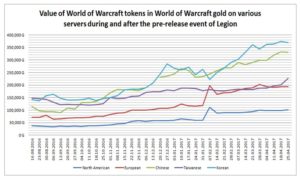
Figure 3: Value of WoW tokens in WoW gold on various servers during and after the pre-launch event of Legion
What remains interesting in Figure 3 is the sudden upward shift in the value of tokens on Western servers and a sudden drop in value on the Korean servers on Tuesday the 7th of February 2017. These spikes may be explained by the update in February 2017, which allows players to exchange bought tokens into a given monetary value of Battle.net ˗ which is Blizzard’s gaming platform ˗ balance. This balance may be used in any of Blizzard’s games with purchasable additional content, such as different skins for playable characters. The amount of Battle.net balance obtained may vary depending on the buyer’s location but, for example, the balance obtained on the North American servers is worth USD$15, which is USD$5 less in value than the original purchasing price of the WoW token.
Considering the upward spikes and the general upward shift in the token’s value on the Western servers, one may come to a conclusion that this development is due to an increase in demand for WoW tokens as they are given an additional purpose. However, the decline in the token’s value on the Korean servers during this release is interesting. It may be assumed that this update could have resulted in an increase in the supply of WoW tokens on the Korean market, as players may have anticipated an increase in demand. It is, however, difficult to make claims one way or another with a lack of evidence, as Blizzard may naturally withhold such information, so these assumptions must be treated only as such. The addition to the WoW token’s functions may have boosted the price development, according to Figures 2 and 3, on most servers – excluding the Taiwanese servers, where the price development for WoW tokens has remained rather steady despite the update.
The Exchange Rate between WoW Gold and the USD$
In order to convert the in-game currency of WoW to real-world currency we must consider the real-world worth of the WoW token on various servers, their value in gold on these servers and study real-time exchange rates to the United States Dollar. Important assumptions to consider are based on the various players’ preferences.
Where a North American seller of the WoW token may gain an amount of WoW gold
which s/he sees to be worth USD$20, the purchaser of the token may value the same amount of WoW gold differently. The token’s purchaser may value it worth USD$13 of game time or USD$15 worth of Battle.net balance. These preferences are important to consider as the value of currency may be heavily influenced by them.
The primary focus, however, will remain on the original purchasing price of the WoW
token, which is USD$20 on the North American servers. This focus is taken because it is the original purchasing price which brought the tokens into the market.
Figure 4 shows the value of 1 USD on various servers in WoW gold. As can be seen, the rise of value of USD in relation to WoW gold accelerated on all servers in September 2016, after WoW’s newest expansion was released.
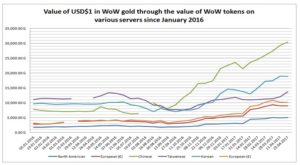
Figure 4: Value of USD$1 in WoW gold through the value of WoW tokens on various servers since January 2016
The conversion of USD$1 into WoW gold on each server is conducted through analyzing real world currency exchange rates and converting the real world value of WoW tokens on different servers into USD as may be also seen in Figure 1. After this is taken into consideration the next step is to consider the market value of WoW tokens in terms of WoW gold. This information is portrayed earlier in Figure 2. Taking into account the real world currency value of WoW tokens, real world exchange rates and the market value of WoW tokens in-game, we may examine the exchange rate between WoW gold and the United States Dollar on various servers, as portrayed in Figure 4.
It is important to recognize that WoW tokens are much cheaper in real world currency on some servers than on others. On Chinese servers the cost may be around USD$11 while on European servers the cost may be nearly USD$22 in Euros, as of 25.04.2017. The differences in real-world value of WoW tokens causes large disparity between the value of USD$1 across servers.
We must also consider the importance of differences in purchasing power across regions. Purchasing power, in short, means how much the price of a given basket of goods and services is and how much its value may vary in different countries. If we were to consider the United States and China, where products in China may be assumed to be cheaper in general, the nominally cheap WoW token price of USD$11 may actually be noticeably more valuable in China than it is in the United States or Europe. Therefore, the opportunity cost of buying a WoW token in China may be higher than first assumed.
In-game Inflation
Inflation is the increase in price levels over time. The decrease of the general price level, on the other hand, is referred to as deflation. Inflation is a common phenomenon in the global economy. Monetary policies are usually used to maintain a low and steady level of inflation without affecting output (Van Zandweghe, 2015). Those who fail to maintain a steady level of inflation may suffer from dire consequences, such as Germany’s hyperinflation in the 1920’s or, more recently, Venezuela, where the value of local currency has plummeted due to failed policies.
Inflation effectively lowers the value of currency. If, for example, you lived in an economy with an annual inflation rate of 10% and had one-hundred euros to buy goods during year X you would get one-hundred euros’ worth of goods. However, during year X+1 you would have to pay 10% more, or 110€, for the same goods. During year X+2 you would already have to pay 121€. Therefore 100€ right now is worth more than 100€ would be a year from now.
Inflation may be often attributed to an increase in available currency. The increase in currency is deemed to be in near unity with inflation (McCandless Jr. and Weber, 2001). When the amount of currency increases, consumers may have more currency to spend on scarce goods and services. As consumers may increase their spending, businesses may increase their prices in order to meet the new market equilibrium, raising the market’s price level. The hypothetical inflation in WoW could be largely attributed to an increase in money supply. This simply means increasing the available money supply through, for example, printing more money. This relates to the WoW printing press discussed earlier where an increased amount of WoW gold is available after a new expansion pack is released.
By creating a high level of inflation through an increase in money supply after each released expansion Blizzard may attempt to push subscribers towards purchasing their newly released expansion packs. Monetary policy in itself might not be the main reason for purchasing a new expansion pack, but it may still influence the game’s subscribers by affecting their gaming experiences. Those who do not purchase the newest expansion packs to WoW would not be able to acquire currency as efficiently as those who have purchased it. Not only would a new expansion pack thus hinder the other players’ experiences by not letting them in on the new fun, it would also effectively weaken the players’ financial situations.
In order to examine inflation, we may observe the rise in value of WoW tokens on each server in terms of WoW gold. The rising price level of WoW tokens may work as an indicator of inflation.
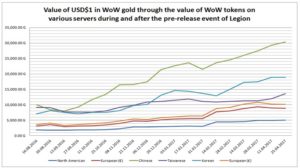
Figure 5: Value of USD$1 in WoW gold through the value of WoW tokens on various servers during and after the pre-release event of Legion
By examining a shorter time period in Figures 3 and 5 we may perceive the level of appreciation WoW tokens have experienced on various servers. With this information we may further assume a high level of inflation occurring within the market.
Table 1: Value of WoW tokens in WoW gold on Western servers during the Legion pre-release event and on 25.04.2017
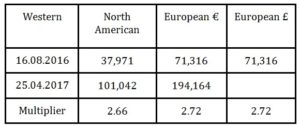
In Figure 5 we may see that the real-world value of WoW gold has fallen noticeably across servers – especially on Chinese servers. On Chinese servers the value of USD$1 during the Legion pre-release event was about 10,000 gold – now it stands at over 30,000 gold. These data shall be further examined through Tables 1 through 6, which show the change in value of WoW tokens between the pre-release event in August 2016 and the end of April 2017. These tables also show the change of value of USD$1 in terms of WoW gold during this same time period.
Table 2: Value of WoW tokens in WoW gold on Eastern servers during the Legion pre-release event and on 25.04.2017
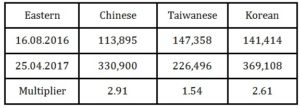
Table 3: Value of USD$1 in WoW gold on Western servers during the Legion pre-release event and on 25.04.2017
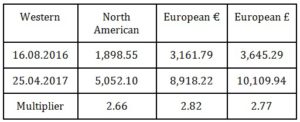
Table 4: Value of USD$1 in WoW gold on Eastern servers during the Legion pre-release event and on 25.04.2017

Tables 1 and 2 display the change in value of WoW tokens in terms of WoW gold between the 16th of August 2016 and the 25th of April 2017 on the studied server regions. These changes in value of WoW tokens are examined through a multiplier, which is obtained by dividing the current value of the WoW tokens with their original value. As can be seen, WoW tokens have experienced the smallest increase in value on the Taiwanese servers, where the current value is 1.54x that of the original value. The largest increase in value has occurred on the Chinese servers, where the current value of WoW tokens is 2.91x, nearly triple, that of the original value.
Observing the change in value of USD$1 in terms of WoW gold, while considering real-world currency exchange rate fluctuations, Tables 3 and 4 display differing multiplier values to those of Tables 1 and 2. Here the smallest increase in value of USD$1 is, once more, on the Taiwanese servers, where the current value is 1.48x that of the original value. The largest increase in value has occurred, again, on the Chinese servers – where the current value of USD$1 is 3.02x that of the original value.
The observation of the change in value of WoW gold both through the values of WoW tokens and real-world currency is important due to real-world currency fluctuations. These WoW token prices are set at a given price level on the server regions in local currencies, rather than floating in terms of USD$. Comparing the differences between the multipliers of Tables 1 and 2 and those of Tables 3 and 4 allows us to estimate the effect which real-world currency fluctuations hold on the WoW economy.
Seeing that the largest negative change between these multipliers is -0.06 on the Taiwanese servers and the largest change is +0.11 on the Chinese servers, we may conclude that real-world currency fluctuations have only had a minor effect on the comparison between USD$1 and WoW gold. This information may also be displayed with the respective real-world currency exchange rates from these time periods in Tables 5 and 6.
Table 5: Exchange rates to USD$1 on Western servers during the Legion pre-release event and on 25.04.2017
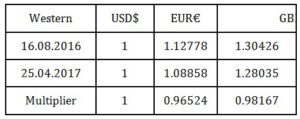
As can be seen in Tables 5 and 6, the changes in exchange rates between the relevant currencies have not experienced great fluctuation during the examination period. The fluctuation between the values of these currencies in terms of USD$ range between -3.78% (in CNY¥) and +3.78% (in TWD$). These exchange-rate changes are the reason for the differing multiplier values between Tables 1 and 2 and Tables 3 and 4. The changes in real-world exchange rates do have an effect on the comparison between WoW gold and the USD$. The effects, however, remain minimal as the real-world currency exchange rates have remained rather steady during the examined time period.
Table 6: Exchange rates to USD$1 on Eastern servers during the Legion pre-release event and on 25.04.2017
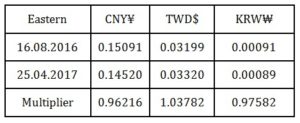
Findings
The currency market in WoW functions much like the real-world currency markets. The in-game currency may be converted into a real-world monetary value, thus theoretically validating it as a form of currency. The currency market may also be manipulated by a central player through monetary policy in order to produce desired results, such as inflation through expansionist policy. Players of WoW may not recognize it, but they are part of an enclosed free market experiment yearning to be studied.
The level of inflation and market effects could be more thoroughly examined, if the data for market transactions within WoW were accessible. An especially important set of data would be the amount of WoW token transactions within WoW during the selected time period. This information could and would be used to support arguments concerning the effects of supply and demand on the market price of the WoW token and would thus allow us to examine the data used in this study more thoroughly.
By only examining the development in the market price of WoW tokens, we are able to assume a high level of inflation, as seen earlier in the data tables. This level of inflation can be connected to two major changes in the WoW market – the release of the game’s newest expansion pack, Legion, and the WoW token’s updated functions. The maintenance of the level of inflation in WoW token prices may also, to an extent, be attributed to the release of new missions and activities in WoW, such as raids. These, however, may be viewed as being directly dependent on the newest expansion pack itself.
(adsbygoogle = window.adsbygoogle || []).push({});
References
- Lastowka, FG. and Hunter, D. (2004) ‘The laws of the virtual worlds.’ California Law Review, 92 (1), 1-73.
- Lehdonvirta, V. (2005) ‘Virtual economics: applying economics to the study of game worlds.’ Proceedings of the 2005 Conference on Future Play (Future Play 2005), October 13-15, 2005, Lansing, MI.
- Lehdonvirta, V. and Castronova E. (2014) ‘Virtual Economics. Design and Analysis.’ The MIT Press, Cambridge, MA.
- McCandless Jr GT. and Weber WE (2001) ‘Some monetary facts.‘ Federal Reserve Bank of Minneapolis. Quarterly Review-Federal Reserve Bank of Minneapolis 25.4: 14.
- Wowtoken (2017) Wowtoken info [Online], Available: http: www.wowtoken.info. [Accessed on August 4, 2017].
6. XE (2017) XE Live Exchange Rates [Online], Available: http: www.xe.com. [Accessed on August 4, 2017].
- Van Zandweghe, W. (2015) ‘Monetary Policy Shocks and Aggregate Supply.’ Economic Review -Federal Reserve Bank of Kansas City 31.













